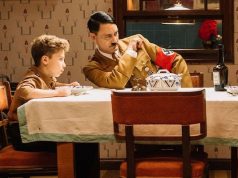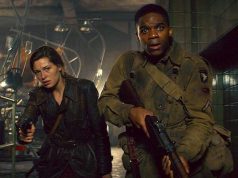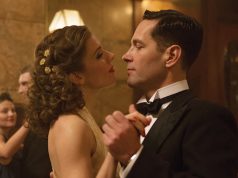Go big or go home, that’s what the athletes say. No point in batting unless you’re going to swing for the fences. “The Boy in the Striped Pajamas” takes that attitude to heart. It’s about a little boy who becomes friends with another little boy who is in a Nazi concentration camp, their camaraderie conducted almost entirely through an electrified barbed-wire fence, with the outsider unaware of his pal’s predicament. A film like this will either succeed terrifically at bringing the Holocaust down to a junior level, or it will fail appallingly. Either way, there’s no question: At least they swung hard.
Because of that, while I don’t think the film succeeds at all, I do find its shortcomings interesting. Based on a novel by John Boyne and adapted by Mark Herman (“Little Voice”), it establishes its themes in its first images: young boys frolicking in a public square in front of Nazi headquarters in Berlin, their carefree laughter at odds with the ominous swastikas in the background. Will this be a film about the loss of innocence? Indeed it will!
The year is 1941-ish, and 8-year-old Bruno (Asa Butterfield) is one of those boys. He and his Nazi officer father (David Thewlis), mother (Vera Farmiga), and 12-year-old sister Gretel (Amber Beattie) are transferred to a new home out in the country when Father is promoted, and from his new bedroom Bruno can see a strange farm off in the distance. The farmers wear striped pajamas. One of them comes to his family’s house to do menial gardening and other labor, and he seems sickly, terrified, and beaten-down. What strange farmers these are!
Bored with his new surroundings, Bruno sneaks away from his house and down the road to the farm. Inside the fence is a boy his age with the funny name of Shmuel (Jack Scanlon), and they become friends. When you’re 8, you can be friends with someone based solely on the fact that you’re both 8. Shmuel tends to hide over in this corner of the yard, away from the more rigorous labor that goes on in the main section. He’s baffled, almost offended, when Bruno thinks the number on his shirt has to do with a game of some kind. Yet he doesn’t explain what the real situation is, either.
Neither do Bruno’s parents or anyone else. There is a conscious effort to shield the children from what’s happening around them; for a while, even Mother isn’t fully aware of what goes on at the “farm” (which is actually Auschwitz, of course). She is shown to be a good-hearted woman who treats the aforementioned prisoner-turned-gardener, Pavel (David Hayman), with decency.
Meanwhile, Gretel develops a crush on a young soldier and starts putting up militant Nazis posters in her bedroom. (You know how teen girls are with their infatuations! One week it’s swing music; the next week it’s Nazism.) Gretel even renounces all her dolls as childish playthings, and there’s an odd moment when Bruno goes into the basement and discovers the discarded dolls piled up like a stack of bodies — a dollocaust, if you will.
The way Herman films this image suggests the parallel is intentional. It’s a movie about a child’s understanding of the Holocaust; it makes sense, at least theoretically, to use a child’s toys as a metaphor. But there’s too much of this kind of silliness — or, rather, things that are supposed to be deep and thought-provoking that come off as silliness. Keeping Bruno in the dark about what’s happening on the “farm” eventually requires so much convoluted lying and misdirection that you can’t take it seriously anymore.
It leads to a finale that is … well, I can honestly say it’s the right ending for this story. If the point is to warn of the dangers inherent in shielding our children from the evils of the world, then this conclusion is perfect. While I can’t say the film had much emotional impact on me — I get the point, but it’s sloppily executed — it’s definitely an unusual attempt.
C (1 hr., 33 min.; )





